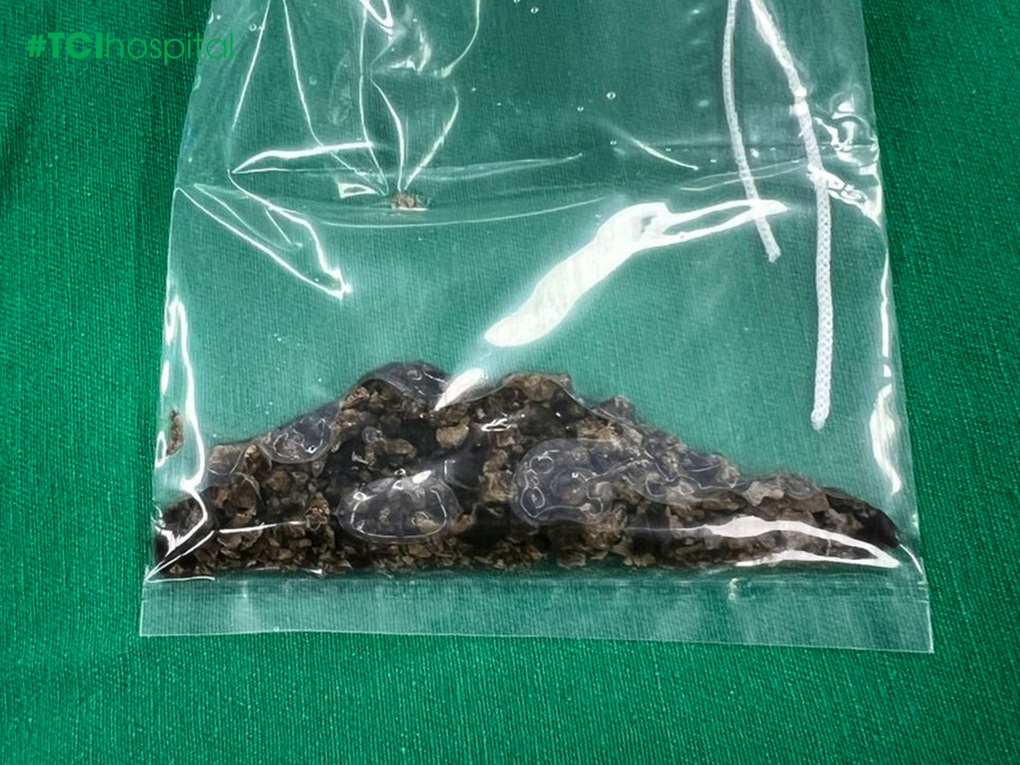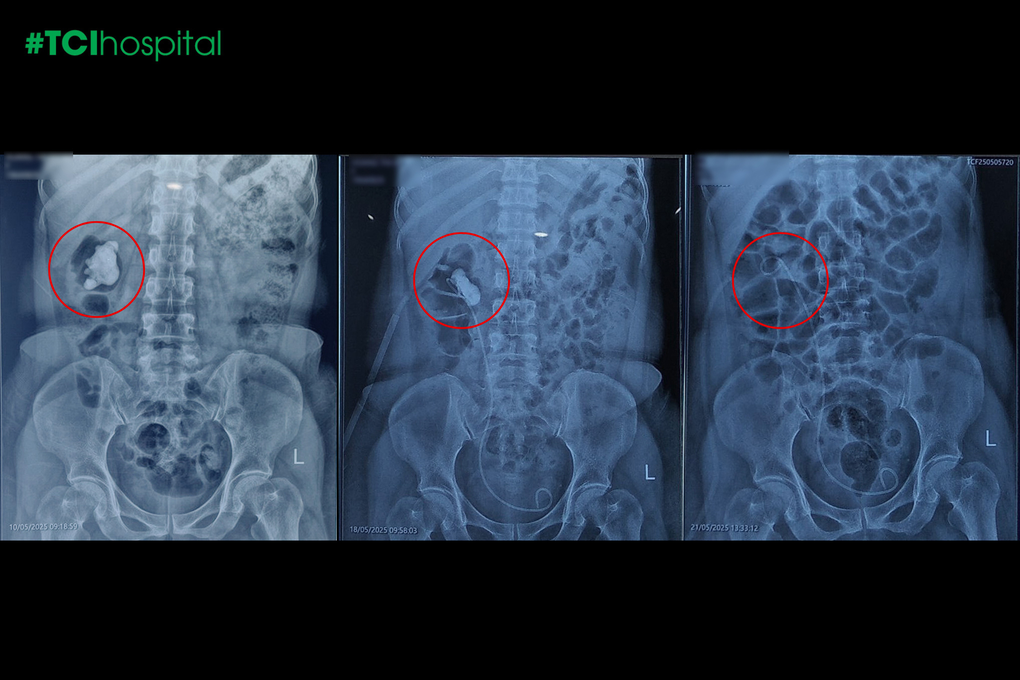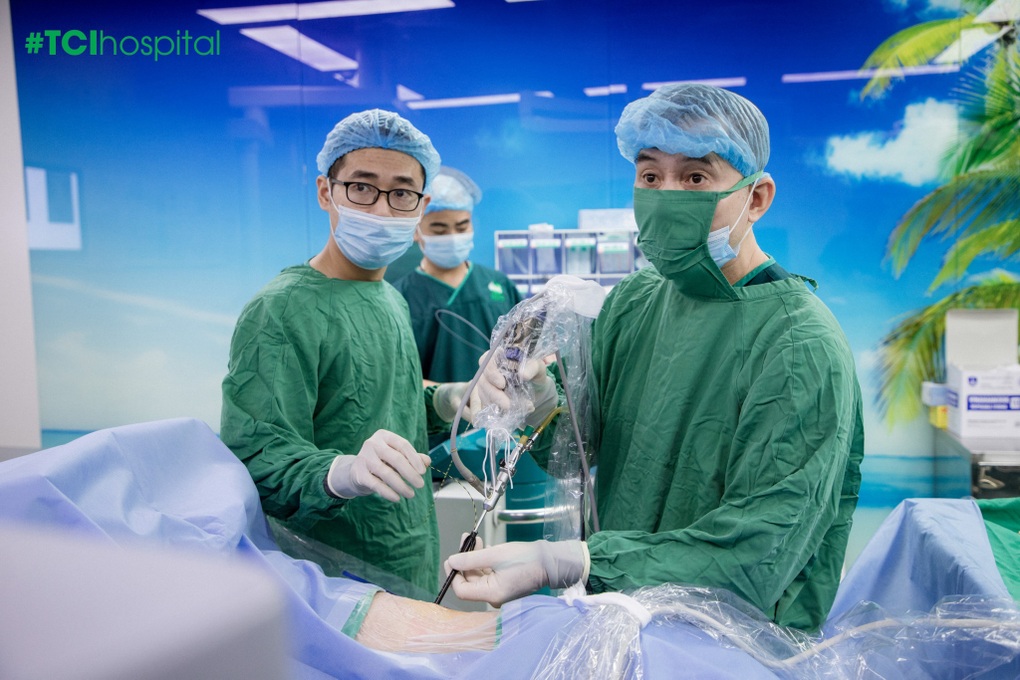Remove all gravel debris like rust particles stuck in the renal pelvis
Ms. HTH (61 years old, Dong Hy, Thai Nguyen ) was discharged from the hospital in a healthy state and with a relieved spirit after having a hard kidney stone removed that had been stuck in her right kidney for many years.
The stone measuring up to 34x36mm, when removed from the body after two laser lithotripsy procedures at Thu Cuc TCI International General Hospital, surprised even the doctors because its shape on the X-ray was like a "limestone", but its "rusty" texture was typical of a long-standing accumulation.
The person who directly performed the lithotripsy was Meritorious Doctor, Doctor CKII Pham Huy Huyen - Deputy Director of Thu Cuc TCI International General Hospital in charge of Urology, said: "When the stone was crushed and removed, the large stone had a rough shape, the surface was dark, solid and rust-colored. This is a typical sign of the type of stone that formed many years ago but was not detected and treated promptly."

Image of kidney stones of HTH patient being crushed and directly sucked out (Photo: TCI).
Late detection due to asymptomatic stones
It is worth mentioning that Ms. H. did not know that she had kidney stones. Before going to the doctor, she did not have any obvious symptoms and her health was normal. Only in the past month did she feel a dull pain in her right lower back, not continuously, but enough to make her worried. Coming to Thu Cuc TCI for a check-up for peace of mind, she did not expect that the X-ray diagnosis showed a large stone nearly 4cm firmly attached to the middle of her kidney.
“When the doctor showed me the X-ray images, I was stunned. I didn’t think I had such a big stone in my body. At first, I thought it was because of old age, overwork, or the weather that I had recently had symptoms,” Ms. H. recounted.
According to Dr. Huyen, Ms. H's kidney stones may have silently formed and accumulated little by little over decades. In many cases, the stones are located in a position that does not block the flow of urine, and the body may not send out warning signals. However, if not detected and treated, the stones will continue to grow, invade and compress the urinary tract, retain urine in the kidney, causing the kidney to gradually expand like a water balloon. At a certain point, the consequences will be infection, pus retention, and even permanent kidney failure.
After a comprehensive assessment of the patient's condition, Dr. Huyen decided to choose the method of percutaneous laser lithotripsy - a modern technique that allows for effective, minimally invasive treatment of large stones and coral stones, while preserving maximum kidney function.
On May 15, the first lithotripsy went smoothly, half of the stone was removed. However, due to the large initial size and solidity of the stone, it required skillful handling to completely remove the stone while still preserving the kidney parenchyma. On May 18, Ms. H. continued to undergo a second intervention to remove the remaining stone fragments.

Stones disappeared after percutaneous nephrolithotomy with laser (Photo: TCI).
Three days later, the test results confirmed that the stones had been completely removed. Mrs. H. was discharged from the hospital in a stable condition, no longer in pain, eating and sleeping well, and in good spirits.
“I feel so relieved. I didn’t think I could recover so quickly after the doctor’s anesthesia,” she emotionally shared.
Small tunnel safely treats large kidney stones for the elderly
Not only does it help to remove rust-like gravel particles that have been deep in the kidney for many years, the laser-assisted percutaneous nephrolithotomy also brings great benefits to elderly patients with weak constitutions like Mrs. H.
“The key point of this method is to create a small tunnel on the skin, go straight to the stone location, then use laser energy to break the stone into small pieces and quickly suck it out. No open surgery, not much invasion, not much blood loss, the patient recovers quickly and has few complications after the procedure,” said Dr. Huyen.
This is also a big plus point of this modern technique, helping patients avoid major open surgery which is risky, especially for the elderly. Hospital stay is short, leaving little scarring, kidney function is preserved almost intact - something that traditional open surgery cannot do.

Percutaneous nephrolithotomy with laser is minimally invasive and preserves the kidney (Photo: TCI).
Asymptomatic kidney stones - don't wait until it's too late
Mrs. H's case is not rare, but a common reality for many people with kidney stones today. The stones develop silently, with few symptoms, and only when signs appear do they have progressed significantly.
Dr. Pham Huy Huyen added: “What worries us is that many patients like Ms. H. come to the clinic and are discovered late. The stones are already large, affecting kidney function. If detected early, from a small size of 5-7mm, treatment is much simpler, sometimes just taking medicine or performing extracorporeal lithotripsy without surgery or hospitalization.”
Doctor Huyen recommends that people with a history of kidney stones, people who drink little water, people who exercise little, etc. should have regular check-ups every 6-12 months. Pay special attention to signs such as prolonged back and flank pain, painful urination, cloudy urine, and difficulty urinating. Even if they are mild, you should not ignore them.
Currently, at Thu Cuc TCI International General Hospital, modern high-tech lithotripsy techniques, minimizing invasion, preserving kidney function are being applied comprehensively and with up to 30% discount, saving costs.
For more information, visit https://benhvienthucuc.vn/tan-soi-cong-nghe-cao-danh-bay-soi-tiet-nieu/
Contact: 1900 55 88 92.
Source: https://dantri.com.vn/suc-khoe/tan-sach-soi-lau-nam-bam-chat-nhu-cac-mang-ri-set-trong-be-than-20250703235240834.htm


![[Photo] The 1st Congress of Phu Tho Provincial Party Committee, term 2025-2030](https://vphoto.vietnam.vn/thumb/1200x675/vietnam/resource/IMAGE/2025/9/30/1507da06216649bba8a1ce6251816820)

![[Photo] General Secretary To Lam, Secretary of the Central Military Commission attends the 12th Party Congress of the Army](https://vphoto.vietnam.vn/thumb/1200x675/vietnam/resource/IMAGE/2025/9/30/9b63aaa37ddb472ead84e3870a8ae825)
![[Photo] Solemn opening of the 12th Military Party Congress for the 2025-2030 term](https://vphoto.vietnam.vn/thumb/1200x675/vietnam/resource/IMAGE/2025/9/30/2cd383b3130d41a1a4b5ace0d5eb989d)
![[Photo] General Secretary To Lam receives US Ambassador to Vietnam Marc Knapper](https://vphoto.vietnam.vn/thumb/1200x675/vietnam/resource/IMAGE/2025/9/29/c8fd0761aa184da7814aee57d87c49b3)

























![[Photo] President Luong Cuong receives President of the Cuban National Assembly Esteban Lazo Hernandez](https://vphoto.vietnam.vn/thumb/1200x675/vietnam/resource/IMAGE/2025/9/30/4d38932911c24f6ea1936252bd5427fa)































































Comment (0)